

Importance of Girl Child Education - Empowering Girls Through Education. CHAPTER 1 Introduction.
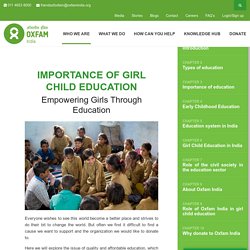
Union Budget 2020: Ways To Reduce Inequality In Education. The Constitution of India has based on the premise that all citizens are equal.
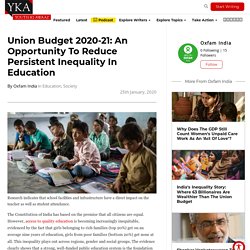
However, access to quality education is becoming increasingly inequitable, evidenced by the fact that girls belonging to rich families (top 20%) get on an average nine years of education, girls from poor families (bottom 20%) get none at all. This inequality plays out across regions, gender and social groups. The evidence clearly shows that a strong, well-funded public education system is the foundation of economic development and people’s life chances. Union Budget 2020: Ways To Reduce Inequality In Education. Top 10 Reasons to Support Girl Child Education - Oxfam India - Medium. Over 28 lakh girls, in the age group of 6 to 13 years, are out of school in India.[1] It is crucial for us to understand the importance of supporting girl child education so we can contribute towards the development of our nation.
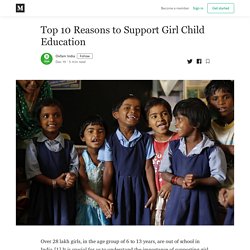
Here are the top 10 reasons to support girl child education in India 1. Empowered women and girlsEducated girls and women are aware of their rights and can make informed decisions for themselves. NGOs Strengthening the Education System in India. Education is the most powerful weapon which you can use to change the world and the most effective way to break out of the cycle of poverty.

Yet, after 70 years of Independence, over two crore children (NSS-2014) still remain out-of-school in India. 10 Facts on illiteracy in India that you must know. 10 facts on illiteracy in India that you must know Literacy constitutes the backbone of development in a progressing country like India. It enhances the quality of life, awareness, and skills of people. What is literacy? Literacy is the ability to read, write and comprehend information in order to communicate effectively. From reading the newspaper to understanding road signs, literacy is the only tool that helps you make sense of your surroundings. 10 Things To Know About The RTE Act, 2009. Failed Education Priorities of the Bihar Government. The green fields on both sides of the Bihar highway leading to Morwa village promise a bounty of vegetables- from cabbage, radish to stacks of paddy that have been recently harvested.

As we enter the Majhi Tola of Morwa village of Samastipur district, the scenery changes dramatically from green fields to dilapidated houses constructed under Indira Awas Yojna. The village is home to one of most marginalised communities in India. One that has been fighting decades of discrimination which has resulted in generations being denied access to education and health facilities. Kept at the periphery: Invisible Musahars Musahar community members from the village work as daily labourers for Rs 100 a day at the lush green farm lands. Why India's girl child deserves a chance at education.
Why India's girl child deserves a chance at education Many of you may already be acquainted with Beti Bachao, Beti Padhao (BBBP), Government of India's campaign to counter declining sex ratio, gender discrimination and low female literacy rate in the country.

The need for schemes such as the BBBP becomes imperative when one looks at the dangerously skewed child sex ratio in India and the prevalent norms that discriminate against the girl child. The adverse socio-economic conditions for a girl child not only impede her growth as a healthy and literate individual but threaten her very survival. Childcare in India today A brief history of child welfare policies around the world Historically, childcare, as an idea has been central to the building of societies.
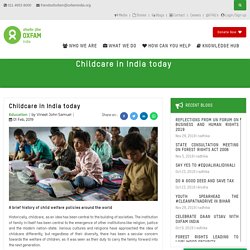
The institution of family in itself has been central to the emergence of other institutions like religion, justice and the modern nation-state. Various cultures and religions have approached the idea of childcare differently, but regardless of their diversity, there has been a secular concern towards the welfare of children, as it was seen as their duty to carry the family forward into the next generation.
Over the passing of time, modern nation-states emerged and childcare moved from being a concern limited to individual family’s, to a concern that was shared by society and the nation. Reflections from UN Forum on Business and Human Rights 2019. Reflections from UN Forum on Business and Human Rights 2019 The recently concluded 8th UN Forum on Business and Human Rights, 2019 is the biggest gathering of civil society, governments, businesses, academics and others working on issues of Business and Human Rights. 2400 people participated in this 3 days forum in Geneva between November 25 – 27, 2019.

The theme for this year’s forum was ‘Time to act: Governments as catalysts for business and human rights’. Below given are the key reflections from the forum: We saw some businesses standing up for critical issues such as living conditions and decent work in supply chains. However, these were very few in number. How Can Education Help A Girl Make Her Dreams Come True? - OpEd - Eurasia Review. Education is important for holistic development of girls and the society as a whole. 59 million children and 65 million adolescents are out of school, across the world, and more than 120 million children do not complete primary education. (1) Education is a human right and policy makers must ensure that each child, especially girl child, is given the education they deserve.
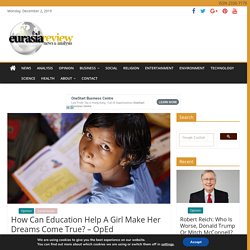
Education helps an individual think critically, understand their environment and the people around them. Education gives women and girls a chance to lead a healthier and happier life. An educated girl is aware of her rights, has the ability to make informed decision for herself, and can stand up against violence and discrimination. She can enter the labour force and contribute towards the development of the country. Child Labour & Child Rights in India. 1 in every 10 worker in India is a child; a child who is guaranteed protections under the Indian Law, and guaranteed an education and mid-day meals, till the age of 14.
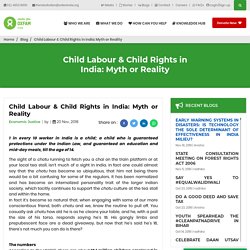
The sight of a chotu running to fetch you a chai on the train platform or at your local tea stall, isn’t much of a sight in India. In fact one could almost say that the chotu has become so ubiquitous, that him not being there would be a bit confusing for some of the regulars. It has been normalized and has become an internalized personality trait of the larger Indian society, which tacitly continues to support the chotu culture at the tea stall and within the home.
In fact it’s become so natural that, when engaging with some of our more conscientious friend, both chotu and we, know the routine to pull off. You casually ask chotu how old he is as he cleans your table, and he, with a pail the size of his torso, responds saying he’s 18. How can you do your bit to save children from being eploited? Girls' Education - NGO Supporting Girl Child Education in India. Oxfam India’s Role In Empowering Girl Child Education In 2018, 7,048 boys and 6,003 girls from our focus areas received quality education. 136 schools and 117 Anagwadi centres were made functional. 440 School Management Committees (SMCs) were made functional in Primary and Upper Primary Schools. When you support Oxfam India’s work, you help end Inequality in education and empower children to become future leaders and change-makers of our country. In just one year, Oxfam India benefited over 13,000 children.
People like you make it possible for us to help the most marginalised children receive quality education. When girls stay in school, they are more likely to build an educated and healthier family, earn a better living, and contribute to the development of the society. Our Vision Oxfam India’s vision is to create a more equal, just, and sustainable world. Our Mission.
Oxfam India supports girl child education. Empowering girls through education 16-year-olds Radha* and Devrani* had to miss regular classes for two months after they were transferred from their school to another that was far from their localities. The schools had to transfer the students because there were too many students, very few teachers and not enough infrastructure to support the students. Consider this: Radha’s class had 97 children; a bench meant to seat two students had three of them jostling for space! Plus not enough teachers meant that they had to rush through the syllabus without any proper guidance. Child Education - A school with no roof. Pragati Wheel School is a one of a kind satellite school in East Delhi, India. Students here are not used to walls or desks and chairs. They are exposed to elements, yet enthused about what each day has to offer. They do not start their day by opening books, instead setting up their school from scratch.
An inspiring story in teamwork and the pursuit for knowledge. Meet the faces of this school. 10 Facts on illiteracy in India that you must know. 10 Things To Know About The RTE Act, 2009. Celebrate Daan Utsav with Oxfam India. What is Daan Utsav (Joy of Giving Week)? Daan Utsav or the Joy of Giving Week is celebrated from October 2-8 every year. Marking its onset on Gandhi Jayanti, this week-long celebration aims at engaging people from different walks of life in various ‘acts of giving’. These acts include giving time, money, resources, and skills. Caste, Class and Education. Today, in 2019, India stands to be the seventh largest economy in the world, while also witnessing a steady increase in the gross enrolment ratio in both men and women portraying strengthening educational system.
However, when it comes to domestic development, more attention needs to be given to issues that have impacts on populations across different States. Concerns remain across key development areas such as hygiene, wages, and educational quality. These are being addressed by the Centre and States through legislative processes and campaigns like the ‘Swachh Bharat Abhiyaan’, ‘Beti Bachao, Beti Padhao’ etc. Oxfamindia's bookmark for "#YesDemocracy. Oxfamindia. Trailblazing on the Path to Education4All. “Seek opportunities to show you care. Devyani goes back to school. Life at Oxfam India. Still wondering what makes Oxfam India the best place to work? Take a sneak peek in #LifeAtOxfam to get your answers. 1. We encourage creativity: Just as for any family the priority is to keep intact the happiness of all family members, at Oxfam India, our employees’ happiness is of utmost importance.
Jharkhand’s Geeta* Goes Back to School. Jharkhand’s Geeta* Goes Back to School Geeta Kumari, a 13 year-old class four student of the Munda community had to drop out of school in 2018. CHILD EDUCATION IN INDIA. Oxfam India organized two state level consultations under education program. Oxfam India organized two state event under education program in Lucknow in collaboration with SCORE, UPFORCES, NCE etc. on 27th and 28th of December.